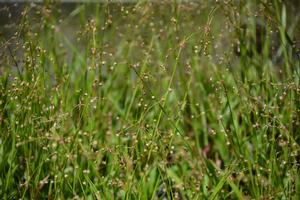Printed at http://www.newmoonnursery.com/index.cfm/
Luzula acuminata
Hairy woodrush
Native to North America
FIRST IMPRESSIONS: Luzula acuminata is a diminutive rush relative that grows in loose sod-like clumps. During early spring, plants in the vegetative state resemble grasses. Leaves are arranged in a rosette and are narrow and shiny with soft silvery hairs. Later in spring, rounded culms with scattered leaves rise from the rosette. The culms bear terminal umbel-like cymes that consist of small yellow, green or brown florets. Small brown capsules follow. Plants thrive in open woodlands with dappled shade and moist soil.
HABITAT & HARDINESS: Luzula acuminata is native in the southern Canadian provinces and the eastern United States from Maine to Florida and west to Wisconsin, South Dakota and Louisiana.
This species is indigenous to many kinds of forests except for those that are extremely wet. Plants occur in rich deciduous woodlands, mixed deciduous-evergreen woodlands, shaded margins of streams or creeks, wooded bluffs, ravines, clearings and fringes of forests.
Hardy from USDA Zones 3-8.
PLANT DESCRIPTION: Luzula acuminata is a rhizomatous cool season perennial.
Basal foliage is flat or has a margin that curls upward. Blades are edged in long silvery hairs and are about ½”wide and up to 12” long. They emerge from reddish pubescent sheaths.
Upright rounded culms emerge in spring. The green culms are clothed in 2-4 leaves about 1” long.
Each culm is terminated by a loose open cyme that is 2” across. The inflorescence bears small starry green, yellow or brown florets. The florets have 6 pointed tepals (3 petals and 3 sepals) and creamy exerted stamens.
Brown or straw colored capsules form after flowering. The capsules retain the scaly tepals.
Plants are 6-12"’ tall with an equal spread.
CULTURAL & MAINTENANCE NEEDS: Luzula acuminata thrives in part sun or lightly shaded sites. Plants prefer moist humus rich soil but grow well in average garden soil.
This species tolerates some drought and seasonal wetness and can adapt to difficult dry shaded sites. Plants tolerate acid or neutral clay and thin rocky or gravelly soils.
This rush relative is pest resistant and unpalatable to deer and other herbivores.
LANDSCAPE USES: Plants are used most often as a Groundcover or pathway Edging for a Shade Garden. They tolerate seasonal water fluctuations and can be planted in Rain Gardens or along the margins of Water Gardens. Luzula acuminata provides some Erosion Control and is useful in Deer Resistant Plantings, Water-wise Landscapes, Low Maintenance Plantings, shady Meadows and Perennial Borders.
COMPANION & UNDERSTUDY PLANTS: Luzula acuminata could be planted in a shady rain garden with Carex socialis, Chelone glabra, Helianthus decapetalus, Osmunda cinnamomea, Phlox maculata and Senecio aureus.
Juncus tenuis is similar in appearance and cultural needs and could be substituted in some situations.
TRIVIA: The word Luzula is said to be from the Italian word lucciola which means “to shine or sparkle”. The name was bestowed because glistening dew drops are held on small hairs near the plants’ stem tips and on the leaves.
The florets of Luzula acuminata have 3 petals and 3 sepals. Since these flower parts are not distinguishable from one another, they are known collectively as tepals or as the perianth. The presence of these floral parts is highly unusual because generally graminoid (members of Sedge, Rush or Grass Families) have no perianths.
Height:
6-12 inSpread:
6-12 ftSpacing:
18-24 inchesUSDA Hardiness Zone:
3-8Bloom Color:
GreenLuzula acuminata Characteristics
Attributes
- Rain Garden
- Ground Cover
- Dried Flower
- Bog
Exposure
- Partial Shade to Full Shade
Flowering Months
- July
Foliage Color
- Red
- Green
Grass Season
- Cool Season Grass
Season of Interest (Foliage)
- Fall
- Summer
- Spring
Soil Moisture Preference
- Moist
Interesting Notes:
F

